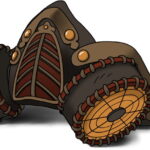Emotional Support Animals are trained to assist their adventuring partners in dealing with anxiety, depression, and some phobias, as well as other mental health traits. They are distinctly separate from Service Animals and, while may receive some similar training, Emotional Support Animals serve a different but equally important role.
Many different creatures can function and be trained as Emotional Support Animals. A half-giant may rely heavily on his triceratops partner to ground him in overly stimulating situations, or a gnome could keep their flying snake draped protectively around their shoulders, functioning as an anchoring tool. A subterranean elf may have colorful oozes as tactile devices, helping with high anxiety or acting as a focus for tasks for which the adventurer is easily distracted from.
General Emotional Support Animal Features
Getting Started. To create an Emotional Support Animal for your character, first choose a creature stat block. We recommend a creature that is a beast type no more than CR 3, though you may elect to choose a creature one size larger than the player character. Unless otherwise stated, Emotional Support Animals retain their ability scores, actions, and abilities while gaining new abilities as they level and grow with their adventuring partner.
Variant Rule: Customizing Ability Scores. When selecting a stat block for your Service Animal, you can elect to keep the ability’s original scores or roll for new stats. Roll 4d6, taking the three highest dice rolls and adding them together. Repeat this five more times. Then assign each totalled number to one of the six ability scores. Alternatively, you can use the standard array 15, 13, 12, 11, 10 and 8, allocating them as previously described.
Keeping Pace. While some creatures can move faster than humanoids, Emotional Support Animals are trained to keep pace with their adventuring partner. Unless otherwise directed, they move at their adventurer’s walking speed.
Spells. Your Emotional Support Animal cannot cast spells — though spells with the range of self also affect them — and you may cast touch spells through your Emotional Support Animal.
Combat. While you and your Emotional Support Animal are Soul-Bounded, their job is to assist you while you are adventuring. As such, while they can attack, they generally only do so in self-defense or in the direst of circumstances. They retain all actions, attacks, or abilities listed on their stat block, but will use their turn to support and assist their adventuring partner before making attacks of their own.
1st Level Features & Above
Proficiencies
Armor: Light Armor (Barding)
Saving Throws: Charisma, Wisdom
Skills: Insight, Medicine, Perception
Soul-Bonded. Starting at 1st level, you and your Service Animal become bonded. Your partnership with each other is the key to becoming successful adventurers. Your Service Animal gains the following benefits:
- Their hit points are equal to your own. You have separate hit point pools, but when you gain a level, your Service Animal’s hit points increase to mirror your own.
- Your proficiency bonus is added to the Service Animal’s AC, attack and damage rolls, as well as any saving throws and skills they are proficient in.
- The Service Animal uses your initiative while in combat but takes their own actions, bonus actions, and reactions separate from yours.
On The Job. Beginning at 1st level, your Emotional Support Animal has become trained to resist all forms of distraction, both magical and non-magical. They are resistant to being charmed and have advantage on saving throws against being controlled by spells such as Dominate Animal, Command, Polymorph, or similar magic.
Attentive. At 1st level, your Emotional Support Animal has been trained to be in tune with your emotional needs. They gain advantage on Insight (Wisdom) checks to perceive your mood and can use their reaction to help you steady yourself in stressful or distracting situations, giving you advantage on Wisdom saving throws for the next minute.
Supportive. Starting at 3rd level, your Emotional Support Animal is able to give you comfort when you need it most. As a bonus action on their turn, the Emotional Service Animal can spend one of their hit dice to help you regain hit points. The amount of hit dice that they can use at a given time increases to 2 dice at level 11 and 3 dice at level 17. All other hit dice recovery mechanics apply, and the Emotional Support Animal can only recover half of the hit dice spent on a long rest.
Ability Score Improvement. When your Emotional Support Animal reaches 4th level, and again at 8th, 12th, 16th, and 19th level, they can increase one ability score of your choice by 2, or they can increase two ability scores of your choice by 1. They can’t increase an ability score above 20 using this feature.
Evasive Maneuvering. At 6th level, your Emotional Support Animal can nimbly dodge out of the way of certain area effects, such as an ancient red dragon’s fiery breath or an Ice Storm spell. When subjected to an effect that allows them to make a Dexterity saving throw to take only half damage, the Emotional Support Animal instead takes no damage if they succeed on the saving throw, and only half damage if they fail.
A Calming Presence. Beginning at level 7, your Emotional Support Animal helps you to remain calm when the world feels like it is closing in on you. As an action, the Emotional Support Animal can exude an aura in a 5-foot radius around them for one minute (as if concentrating on a spell). While in this aura, you have advantage on saving throws to become frightened, and you become immune to any illusory magic that would alter your perception of reality such as Phantasmal Force, Hypnotic Pattern, or Major Image. This aura extends to 15 feet at level 11 and 30 feet at level 17. The Emotional Support Animal can use this feature a number of times equal to your proficiency bonus, and regain all expended uses at the end of a long rest.
Reactive. Beginning at level 11, your Emotional Support Animal has honed their attentiveness even further. Instead of taking one reaction, they can now take two reactions per turn.
Guiding Support. Starting at 14th level your Emotional Support Animal can assist you by guiding you through new areas and crowded spaces. The Emotional Support Animal gains advantage on Perception (Wisdom) checks to navigate through new locations, choosing the best path to take.
Take It From the Top. At level 18, your Emotional Support Animal is able to bolster your confidence when it comes to difficult tasks. If you fail an ability check or saving throw, they may use their reaction to help you attempt to reroll, using the higher of the two outcomes. The Emotional Support Animal can use this feature a number of times equal to your proficiency bonus, and regain all expended uses at the end of a long rest.





